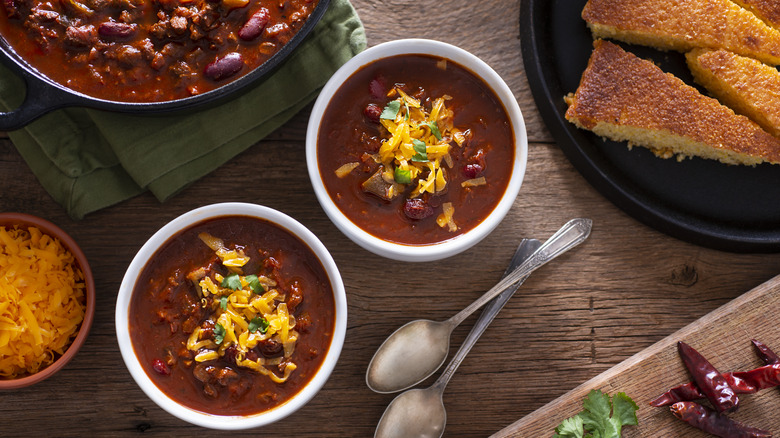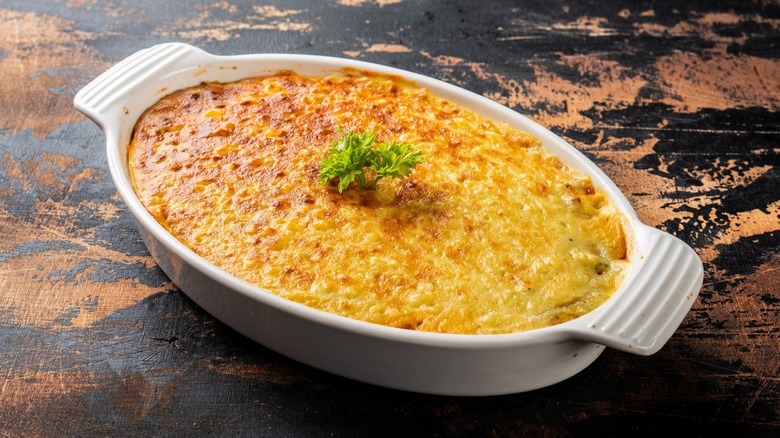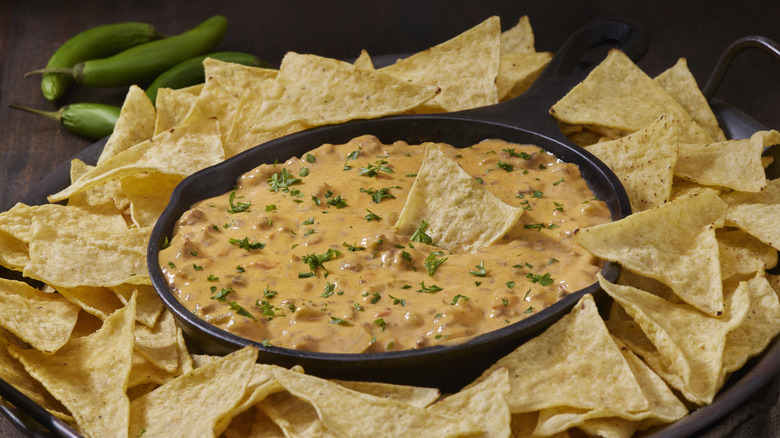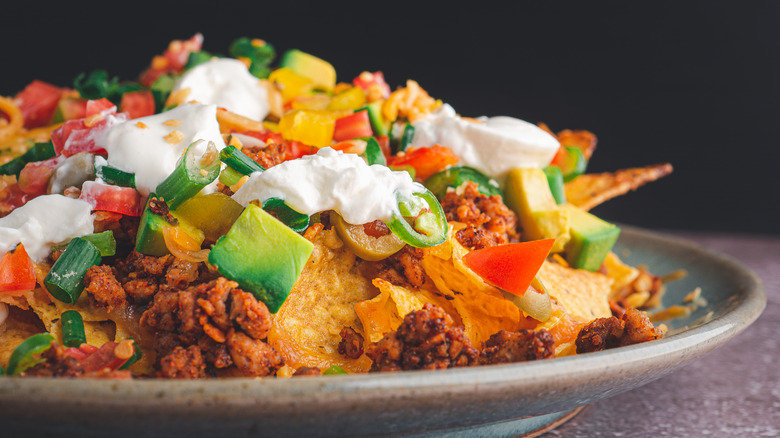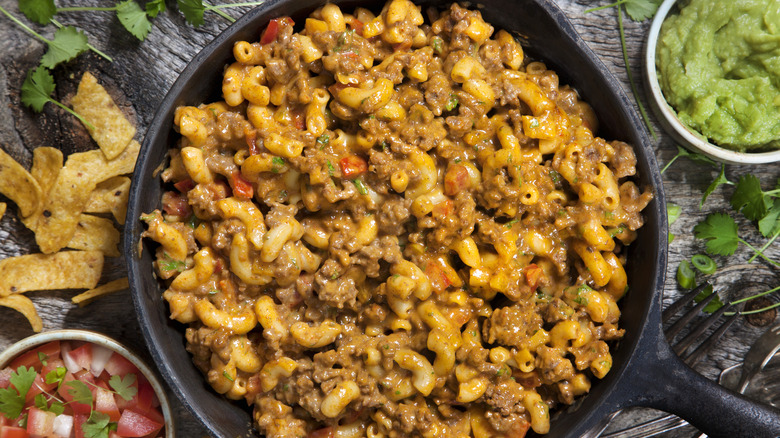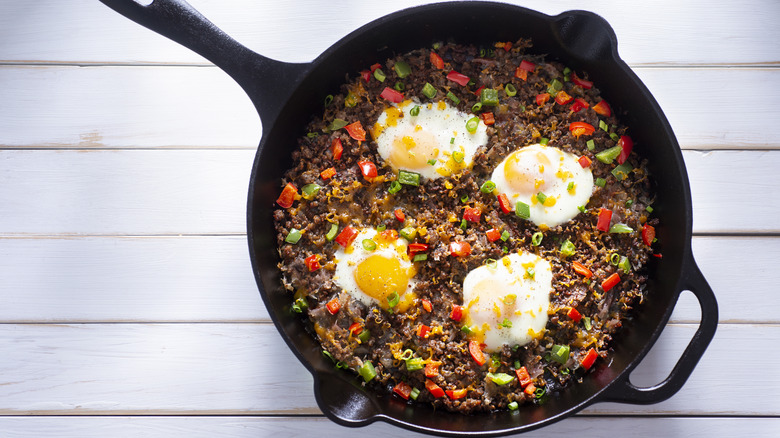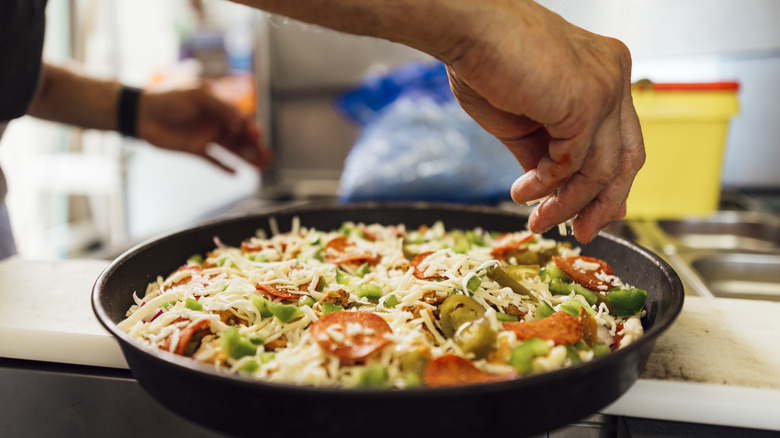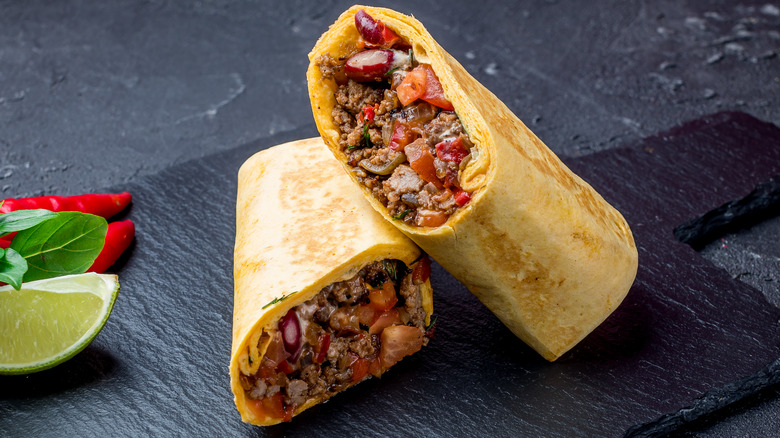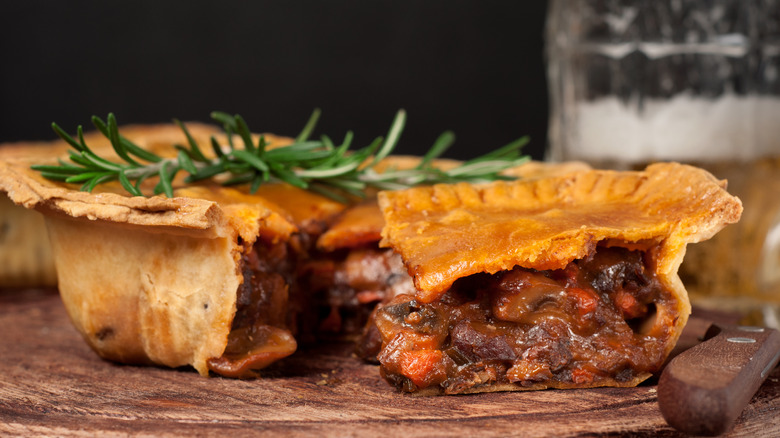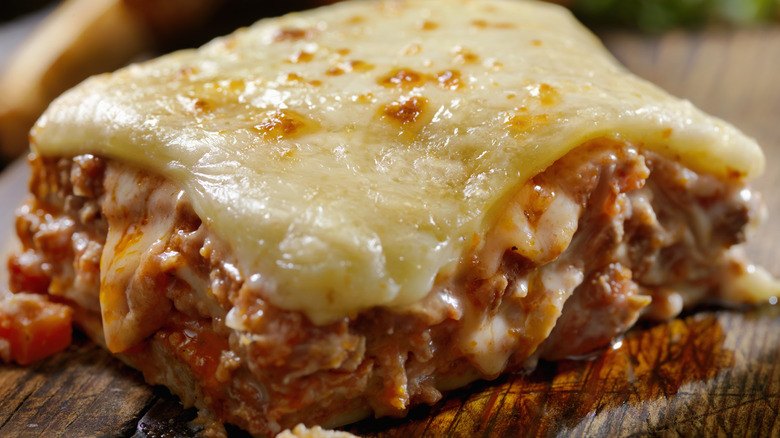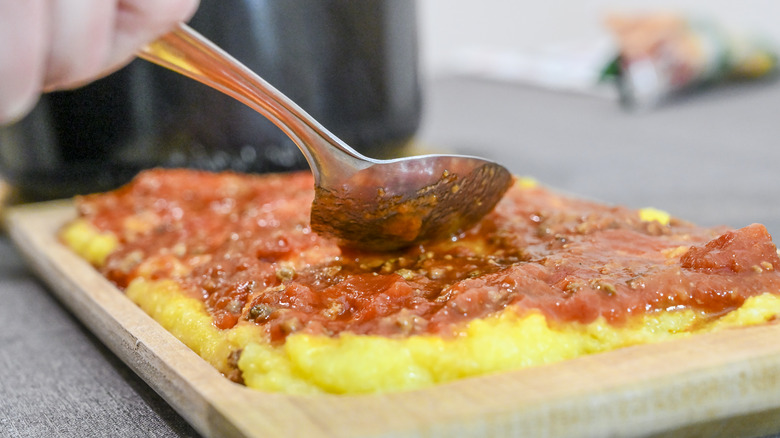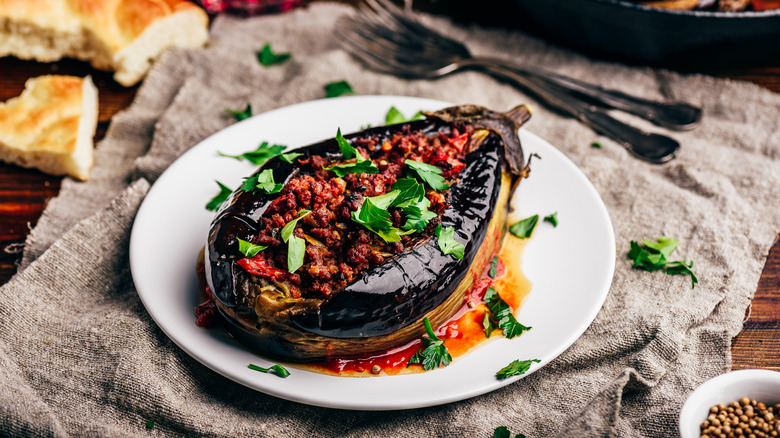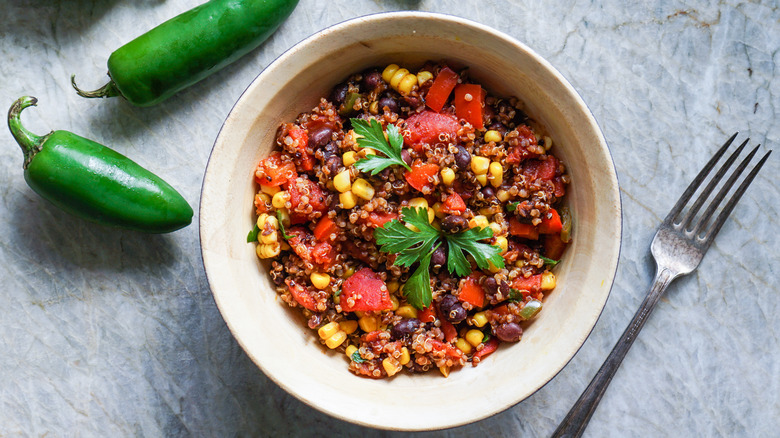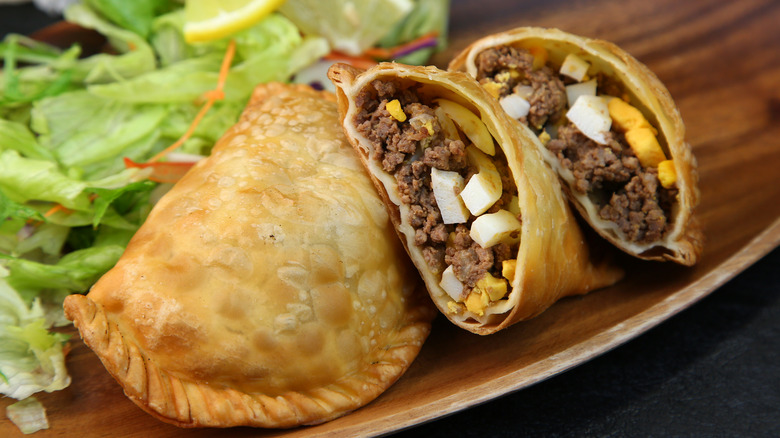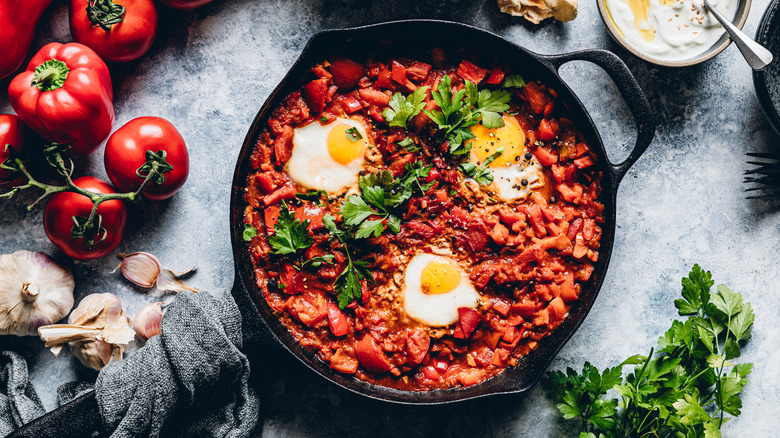What Exactly Can You Do With Leftover Chili?
Though its origin is deeply rooted in southern Texas, chili has evolved into an American all-star with a national identity and numerous regional variations. Despite various differences, all adaptations still reflect Texan roots and Mexican heritage, and they all share a familiar, ultimately comforting trait. Chili now holds a cult status in the U.S., and though it's a common restaurant staple, it is also something you will often see bubbling in home kitchens, as we all agree that nothing beats the homemade version. But we're not here to discuss the proper way to make chili. We are here for the next day when all that leftover chili needs to find a new purpose.
Luckily, chili is one of those dishes that always tastes better the next day. Whether you're whipping up your own or opting for a canned version — no judgments here — chili stores easily, reheats well, and is quite convenient to reuse. However, we usually rely on loaded potatoes, chili fries, and hot dogs, ignoring a list of potentially amazing alternatives. If you are tired of predictable suggestions, this piece will give you a fresh perspective on making the most of leftover chili. It might even inspire you to make a bigger batch next time so you can stretch it up and use it for these creative ideas.
Stuff the chili inside a casserole
Casseroles are generally very convenient and possibly the ideal way to use leftover ingredients. They are easy to prep and require minimal skill, but despite being so inherently simple, they always result in a hearty and satisfying meal that best works as a weeknight dinner.
The idea of incorporating chili into a casserole may sound questionable, but these two classics share a similar comforting character, which will result in the ultimate symphony of flavors and textures. This concept works with most chili varieties as they all pair with classic casserole ingredients. You can keep it simple and layer the chili with potatoes, rice, or pasta, but this casserole chili combo is a great canvas to play with other additions. If you want more tender sweetness, try roasted sweet potatoes or go for other veggies to keep things on the lighter side. Layer the chili with tortillas, add a handful of corn, and be generous with the cheese for the perfect Mexican-inspired casserole. Keep it classic by topping it with cornbread, and for a totally hassle-free experience, ladle the chili into a deep dish, cover it with tater tots, and enjoy the perfect medley of gooey and crispy textures.
Turn it into a dip
Dips should not only be reserved for parties and similar gatherings. They are supposed to be an everyday staple as they can seriously upgrade your snacking game, and with minimal effort, you can play, be creative, and diversify your meals and snacks. Though classics such as guacamole, salsa, queso, or hummus are always welcomed, sometimes you want something more substantial, a dip that would make a meal in itself, and that's where your leftover chili comes into play.
Though it's not common practice, turning leftover chili into a dip may be the most ingenious culinary trick to have on hand. Chili already has the dip-like consistency, so you just need to amp up creaminess to make it easier to scoop. And the best way to do it is to add cheese. If you want to tone down flavors, use cream cheese, but if you like more cheesy savoriness, use a handful of grated cheddar that will melt and hold everything together. You can add jalapeños, chopped onions, or peppers to boost freshness and give the dip some crunch. This chili dip is best served with tortilla chips. The combination will mimic the classic chili and corn flavors we commonly see together. Alternatively, crackers or bread would also work.
Make nachos
Nachos usually consist of layers of crispy tortilla chips stacked with cheese, sauces, and garnishes. This glorious combination makes the perfect centerpiece and easily wins the title of the world's best communal snack. At its core, nachos require nothing more than crispy chips and gooey cheese, but in reality, the combination leaves room for many creative additions. Some traditional garnishes that usually appear in the combo are sour cream, guacamole, jalapeños, peppers, salsas, and olives. Meat is not a stranger, with flavorful ground meat mixes being the absolute favorite addition, and that's why any leftover chili can be used as the perfect garnish for an extra sloppy nacho version.
Beef chili and ground meat used for nachos share a similar flavor profile, but with chili, you get the bonus in the form of beans and veggies. Though chili usually has a much thinner texture, this is not an issue, as it will make the ultimate gooey nacho version. Apart from the classic beef-based version, turkey, chicken, and even vegetarian chili would work in the combination. For a slightly healthier alternative, replace store-bought tortilla chips with thinly sliced roasted potatoes.
Mix it into pasta
This solution for your leftover chili is the unusual fusion that you never knew you needed but might become a staple on your weekly menu. There is nothing revolutionary about mixing pasta with a meat-based sauce — think of tagliatelle served with glorious Bolognese — but chili and pasta have always stayed in separate regional domains, and you'd usually see chili partnered with rice or bread. However, traditions should sometimes be broken, and partnering leftover chili with a bowl of chewy pasta should be celebrated more often as it results in a comforting and satisfying dish.
Most pasta varieties will work here. If you want more saucy goodness to adhere to the pasta and get into the nooks and crannies, choose penne or rigatoni, but fusilli or classic macaroni are also great options. Also, don't dismiss the long and thin varieties such as spaghetti, fettuccine, or tagliatelle, as they also can scoop a lot of sauce. As chili already packs enough flavor, additions are unnecessary, but sprinkling a handful of cheese will produce a beautiful blend resembling a protein-boosted version of mac and cheese.
Whip up a breakfast skillet
Breakfast skillet is a general term encompassing various breakfast dishes made in one skillet. It's easy to understand why people love the idea. These dishes usually have no restrictions regarding ingredients, so you can build the skillet with whatever you like or use whatever you have on hand. Generally, you will see potatoes, beans, sausages, and eggs cooked into a crispy kaleidoscope that packs plenty of carbs, proteins, and fiber. Another great thing about breakfast skillet is that cleaning and prep are usually a breeze. When you feel you're up for a hearty breakfast and have some last night's chili in the fridge, a breakfast skillet is a fantastic way to use the chili and make a warm, nutritious breakfast.
The preparation is fairly simple: add chili to the skillet and let it simmer and bubble. You can elevate it with bacon and sausage or top it with an egg. A handful of shredded cheese is always welcomed, but you can just sprinkle some peppers or scallions to add freshness. This dish only requires crusty bread on the side, and yes, it's perfectly acceptable to eat straight from the skillet.
Put it on top of pizza
Topping your pizza with leftover chili is yet another unconventional fusion, but there is no reason it would not work — just picture the tender pizza dough holding oozy, spice-laden chili filling. You can work with meatless versions, but classic beef chili is preferred here as the dough can use some of that savoriness from the meat.
Chili should be spread thinly, and then you can tweak your pizza any way you like. If you want to amp up the heat, add sliced jalapeños or lightly drizzle chili oil. A handful of corn or thinly sliced fresh peppers would add some crunch and provide much-needed brightness. Though all the add-ons are optional, you should not skip the cheese. Use mozzarella or cheddar, which have excellent melting properties, and sprinkle generously over the chili. The cheese will seal the meat and prevent it from drying out.
For this suggestion, feel free to use store-bought pizza dough or ready-made crust, but if you're feeling particularly ambitious, try to whip a homemade version. You can shape the pizza as you wish, but make sure not to stretch the dough too thin, as you need some structure to hold on to the filling.
Use it for burritos and quesadillas
Chili finds a familiar partner in this pairing. Burritos and quesadillas are often filled with ground meat mixes, so it seems logical that chili could work in this combination. To make the burrito, you can reheat the chili and then pack it into large tortillas. From there, you can go with standard garnishes that usually include beans, lettuce, tomatoes, and sour cream, though the possibilities are seemingly endless. Then, just wrap everything tightly, and you are ready to enjoy the burrito package. Besides the regular stacked burrito, it's also worth mentioning that you can make a wet burrito variety that comes doused in enchilada sauce and topped with cheese, making a much more indulgent version.
Quesadillas are another perfect vessel to tuck in the leftover chili to create a fantastic new dish. They can be made with corn or flour tortillas, and though quesadillas were not initially packed with meat, this version has become somewhat standard these days. Chili would work great in a quesadilla as you can fill it to the brim, top it with copious amounts of cheese, and then fold it and toast it in a pan or a toaster. It does not get better than the satisfying combination of crispy tortilla, warm chili, and melted cheese.
Make pot pies
Pot pies are generally great for using up any leftovers, and they also come through in combination with chili. You can use the chili as is, but feel free to make any adjustments if you feel creative. Use a deep baking dish and spread the chili evenly, making it as thick or thin as you want. You can opt only for the top crust or make the top and the bottom to fully encase the chili. The classic pastry crust is always reliable, but puff pastry would also work. If you want to mimic the classic chili and cornbread combination in a different form, consider using cornbread batter as the top crust. The major benefit here is that this pie comes together quickly, and if you want an even easier route, grab a ready-made pastry from the store.
As a bonus idea, look for an English classic, the comforting shepherd's pie. Instead of the regular ground meat mix, top the leftover chili with a generous amount of creamy mash. Leave the combination in the oven until the potatoes attain a subtle crisp and the spice-laden chili starts to bubble.
Maka lasagna
Lasagna is a delicious but rather complicated dish to make. Assembled with layers of chewy pasta entangled with a juicy meat ragù, heaps of cheese, and béchamel sauce, it takes hours to prep and have the dish on the table. But if you start with leftover chili and swap it for the meat ragù, you might not create the classic Italian lasagna, but you will get an equally satisfying dish that can be whipped up in no time.
Though the flavors in an authentic American chili and the Italian meat sauce can't compare, the textures are similar, so you can expect that chili will do an excellent job nestled between the pasta layers. Chili and cheese are the tried and tested combination that will also work in this lasagna-style dish. You can skip the béchamel, but if you want a creamier version, feel free to leave it in. Béchamel is relatively neutral in flavor and will pair nicely with chili.
Serve it over polenta
Polenta is yet another Italian classic that can be described as the epitome of home and comfort. Made from ground corn, the term polenta is used for the flour-like mix and the dish made from it. Polenta can vary in texture and color, but in most cases, it has an attractive golden hue. It is traditionally cooked with water until it attains this porridge-like consistency. Polenta should always be creamy, but it will become firm and stiff as it sits and chills. Chilled polenta can be grilled and served as a side dish, but the best way to enjoy it is while it is piping hot and creamy. Ideally, you would have it topped with a luscious, gooey sauce. Though you'll never see Italian polenta served with chili, this is your cue to try it, as there is no reason why it wouldn't work. Polenta has a relatively neutral character that makes an excellent base for the flavor-packed chili.
Instead of polenta, you can always use grits. Though many believe grits and polenta differ only in name and origin, the two are traditionally made from different types of corn and result in slightly different dishes. While polenta has a fine texture and a creamy mouthfeel, grits are usually coarser and give off an uneven, rougher finish. But, in this case, both can serve as a great framework for the leftover chili.
Pack it inside veggies
Stuffing vegetables with meat sauces is not an anomaly, but you will rarely see chili used for the purpose. However, the consistency of the chili is ideal for packing inside hollowed veggies. Zucchinis and eggplant are perfect for these recipes. These two are relatively large, which makes scooping out more convenient, leaving room to pack more sauce. The veggies will soften as they bake, providing a fork-tender base for the meaty filling. Adding cheese and sour cream on top of this combination almost seems obligatory. Apart from zucchini and eggplants, bell peppers can make a great veggie plate for chili.
This is a great idea even for those who are not too big on veggies. Chili will remain the dominant ingredient, but you'll get just enough veggie freshness to brighten the whole combination. Think of this idea not only as a way to use leftover chili, but also as a great way to empty the salad drawer and utilize the sad-looking veggies.
Build it into breakfast and grain bowls
Grain bowls are all the rage these days, mostly because people appreciate their convenience and creative potential. Grains typically make the base, while the toppings can include various fresh or cooked veggies, tofu, legumes, meat, or fish, all topped with a flavor-packed creamy dressing. Though it cannot be considered a standard, turning leftover chili into an ingredient to top off your grain bowl seems ingenious. Chili will go well with any grain standardly used for these bowls, and you can also tweak it with add-ons to create a less or more substantial dish.
If you are a fan of a big, savory breakfast, you can even repurpose leftover chili into a filling breakfast bowl. These bowls often include smoothies or oatmeal as a base, usually dotted with light breakfast-like ingredients, primarily fruit, granola, seeds, nuts, and yogurt. In the savory version, the combinations often include potatoes, sausages, avocado, or eggs, and you can always use a dollop of last night's chili as a perfect protein-lade accompaniment. Though sweet and fruit breakfast bowls can be chilled, these savory versions are best served slightly warmer.
Stuff it inside empanadas
Empanadas are crescent-shaped pastries that you'll find across Latin America. Though it's not clear where they originated, empanadas have become a staple in several national cuisines, and it's easy to understand the appeal. They are incredibly convenient and easy to transport, which makes them a great snack to have on the go, and the creative fillings can pack a lot of flavor and nutrients. Though the fillings vary, some classic options include meat, usually beef or chicken, tuna, cheese, vegetable empanadas, and several sweet varieties.
Due to the striking resemblance to the classic ground beef filling, you can use any leftover chili as an alternative empanada filling. You just have to ensure that the chili is thick enough to be used inside the pastry. If it's too runny, you can always cook it until it reaches the desired consistency. For a hassle-free experience, you can use store-bought pastry. Just tuck a spoonful of chili inside the dough, seal carefully with a fork, and bake until golden.
Use it to bake eggs
If you are looking for a warm and comforting dish to use up all the leftover chili, try using it as a base to cook your eggs. The idea mimics the classic shakshuka technique in which eggs are spooned into spiced and thickened tomato sauce. As the saucy tomato simmers, the eggs are slowly cooked, resulting in tender, poached eggs with a bonus of aromatic tomato sauce that creates a wholesome meal. If you have leftover chili, use it instead of tomato sauce. Heat the mix in the skillet, use a spoon to create round pockets, and slip your eggs inside them.
This idea will work with any chili variety. Just make sure to heat the chili well before adding the eggs. If the chili is too cold, the eggs may ooze through pockets and not set properly. You want the egg to start cooking immediately as it comes into contact with the chili. For foolproof execution, crack your eggs in a separate bowl. The technique will prevent cracked shells inside the chili and broken yolks that will inevitably become chewy and overcooked.
